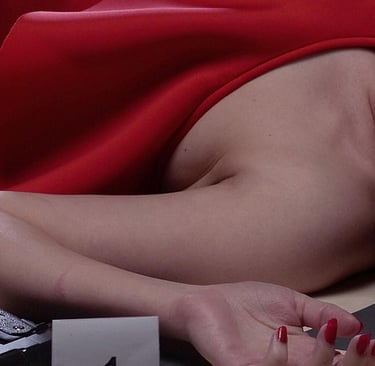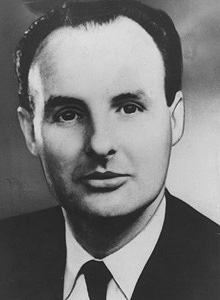

TrueCrime Tales
Gripping real-life stories of murder, mystery and justice. Step into the darker side of life with detailed, compelling narratives you won’t be able to put down.


ARCHIEBALD HALL
The 1970s in Britain were a tumultuous time, but amidst the social upheaval and rising crime rates, certain narratives stood out for their sheer depravity and calculated cruelty. Among them is the chilling tale of Archibald Thomson Hall, a man who meticulously crafted a new identity as a refined butler while indulging in a dark, murderous spree that crisscrossed the United Kingdom. Assisted by various accomplices, his crimes would earn him the moniker “The Monster Butler” and send shivers down the spine of a nation.
I. From Glasgow Thief to “Roy Fontaine”: The Making of a Killer
Archibald Thomson Hall was born in Glasgow, Scotland, on June 17, 1924. His early life was characterized by petty crime and a desire to escape his working-class roots. From a young age, Hall demonstrated a natural talent for theft, beginning with pickpocketing and progressing to housebreaking. He was a chameleon, effortlessly adapting to different social circles, often leveraging his bisexuality to infiltrate London’s affluent gay scene, where he engaged in lucrative criminal ventures.
Hall’s criminal career was punctuated by numerous arrests and lengthy prison sentences. However, rather than deterring him, incarceration became a peculiar form of education. During his stints in various British prisons throughout the 1950s and 60s, Hall dedicated himself to self-improvement. He devoured books on antiques, studied the etiquette of the aristocracy, and even took elocution lessons to soften his Glaswegian accent. He cultivated an air of sophistication and adopted the alias “Roy Fontaine,” a name he felt befitted his new persona as a gentleman’s gentleman. He envisioned a life of luxury, not through honest work, but through exploiting the wealthy elite he now sought to imitate.
By the time he was released from his latest prison term in 1975, at the age of 51, “Roy Fontaine” was ready to embark on what he hoped would be his grandest criminal chapter. He secured a position as a butler at Kirtleton House, a stately home in Dumfriesshire, Scotland, owned by the elderly Lady Margaret Hudson, the dowager Lady Hudson. His charm and impeccable manners initially made him a seemingly ideal employee.
II. The First Victim: David Wright and the Seeds of Murder
Hall’s tenure at Kirtleton House seemed, for a brief period, to offer him a semblance of the legitimate life he craved. He genuinely liked Lady Hudson and, unusually for him, appeared to genuinely consider not robbing her. This fragile facade, however, was shattered with the arrival of David Wright.
David Wright was a former lover of Hall’s from one of his prison terms. In 1977, Hall arranged for Wright to be employed as a gamekeeper on Lady Hudson’s estate. Wright, a man with his own criminal past, soon proved to be a liability. He stole a valuable diamond ring belonging to Lady Hudson. When Hall confronted him, Wright not only refused to return the ring but also threatened to expose Hall’s own extensive criminal history to their employer if Hall reported him. This blackmail, coupled with the disruption of Hall’s carefully constructed image, enraged the calculating butler.
Hall decided Wright had to be silenced. On December 12, 1977, under the guise of a rabbit hunting trip to clear the air, Hall lured Wright into the remote grounds of Kirtleton House. Once they were deep in the secluded countryside, Hall produced a rifle and shot David Wright dead. He then meticulously buried Wright’s body near a stream on the estate, believing the remote location would ensure its permanent concealment. This act marked Hall’s chilling transition from a master thief to a cold-blooded murderer.
III. A New Accomplice and a New Spree: The West End Murders Begin
The murder of David Wright forced Hall to quickly abandon his position at Kirtleton House, as Lady Hudson soon became suspicious of his past. He fled back to London, seeking to restart his criminal enterprise. It was here that he met Michael Kitto, a young, opportunistic petty criminal who would become his next, equally ruthless, accomplice.
Hall, reverting to his “butler” persona, found employment caring for an elderly and wealthy couple, former Labour MP Walter Scott-Elliot (82) and his wife Dorothy (60), at their flat in London’s exclusive West End – hence the later media moniker for the crimes. Hall’s initial plan, as always, was to rob them blind and retire in luxury. However, fate, or rather, Dorothy Scott-Elliot, intervened.
On December 21, 1977, as Hall and Kitto were discussing their plans to rob the flat, Dorothy Scott-Elliot unexpectedly walked in on them. Without hesitation, Michael Kitto, in a brutal initiation into murder, grabbed a pillow and suffocated her. This spontaneous act of violence elevated their criminal partnership to a new, terrifying level.
Panicked but resourceful, Hall and Kitto decided to dispose of Dorothy’s body by driving it north to Scotland. They enlisted the help of Mary Coggle, a former prostitute and casual acquaintance who had been working as a housekeeper for the Scott-Elliots. Coggle, unaware of the full extent of their monstrous actions, accompanied them on the grim journey. Dorothy’s body was buried in a shallow grave near Braco, Perthshire.
Walter Scott-Elliot, still alive but heavily sedated by the pair, was also driven north. On December 23, 1977, two days after his wife’s murder, he was beaten to death with a shovel and buried in a remote woodland near Tomich, Inverness-shire.
IV. The Fatal Flaws: More Victims and the Trail of Discovery
With the Scott-Elliots disposed of, Hall and Kitto returned south, but the body count was not yet complete. Mary Coggle, the unwitting accomplice, had become a liability. She had begun wearing Dorothy Scott-Elliot’s expensive clothes and jewellery, drawing unwanted attention to herself and potentially linking her to the missing couple. Furthermore, she refused to dispose of a distinctive fur coat that could be incriminating evidence. Hall decided she had to go.
On Christmas Eve, 1977, Hall and Kitto murdered Mary Coggle with a poker, beating her to death. Her body was then dumped in a stream near Middlebie, Dumfriesshire. Her partially clothed remains were discovered by a shepherd on Christmas Day, marking the beginning of the end for the murderous duo. The discovery of an unknown female body was reported, but the identity of “the lady in the stream” remained a mystery for a time.
Hall’s final victim was his own half-brother, Donald Hall. Donald was a paedophile who had recently been released from prison. Archibald Hall, despite their familial connection, harbored a deep-seated hatred for him. In early January 1978, Hall and Kitto located Donald at Hall’s holiday home in Cumbria. They tricked him into believing they were planning a robbery that required them to practice tying someone up. Once Donald was securely bound, Hall used chloroform to incapacitate him before drowning him in the bath.
V. The Unravelling: A Roadside Stop and Inevitable Justice
The disposal of Donald Hall’s body proved to be the undoing of Archibald Hall and Michael Kitto. They placed Donald’s body in the boot of a car and again drove north towards Scotland for burial. However, Hall, in a moment of superstitious folly, had made Kitto replace the car’s number plate which contained three 9s (which he considered unlucky). This meant the tax disc and the number plate did not match, a minor infringement that would lead to major consequences.
On January 16, 1978, the pair stopped at a hotel in North Berwick, Scotland. The hotelier became suspicious of their shifty movements and, worried about payment, called the police as a precaution. When officers arrived, they quickly noticed the discrepancy between the car’s tax disc and its number plate. Hall and Kitto were taken in for questioning.
Inside the police station, Hall attempted suicide by overdosing on barbiturates. His failed attempt resulted in hospitalization and a stomach pump, but it also raised immediate red flags for the investigators. A further police check connected Hall’s car to a suspicious transaction involving antiques in Newcastle-under-Lyme, where two men had offered valuables well below their true value.
The police traced the car to the Scott-Elliots’ London address, finding the apartment ransacked and spattered with blood. This, combined with the discovery of Mary Coggle’s body (now identified and linked to the Scott-Elliots as their housekeeper), created a terrifying picture. During interrogation, Hall, under pressure and perhaps believing his game was up, began to reveal the horrific truth. He confessed to the murders and, critically, disclosed the burial sites of David Wright and the Scott-Elliots. In deep snow and freezing conditions, police teams, under intense media scrutiny, meticulously excavated the remote graves, confirming Hall’s gruesome admissions.
VI. Conviction and Legacy
Archibald Hall and Michael Kitto were charged with multiple murders. Due to the geographical spread of their crimes, Hall faced separate trials in London and Edinburgh.
Archibald Hall was ultimately convicted of five murders: David Wright, Walter Scott-Elliot, Mary Coggle, and Donald Hall. Dorothy Scott-Elliot’s murder was ordered to lie on file, meaning he was not formally convicted of it but would not be retried. He received multiple life sentences, with judges recommending that he should never be released. He died in prison in 2002 at the age of 78, still the oldest prisoner serving a whole life tariff at the time of his death.
Michael Kitto was also convicted of his role in three of the murders (Dorothy Scott-Elliot, Walter Scott-Elliot, and Mary Coggle) and also received life imprisonment. Police evidence suggested that Kitto was, in a perverse way, fortunate to be arrested when he was, as Hall reportedly had plans to kill him next to eliminate another witness.
The West End Murders, as they became known, highlighted the dangerous allure of seemingly respectable figures who harbored dark secrets. Archibald Hall, the “Monster Butler” or “Roy Fontaine,” remains one of Britain’s most chilling serial killers, a man who, through meticulous planning and cold-blooded ruthlessness, exploited his chosen profession to commit acts of extreme violence, leaving a trail of death across the United Kingdom before a simple traffic stop finally brought his reign of terror to an end.